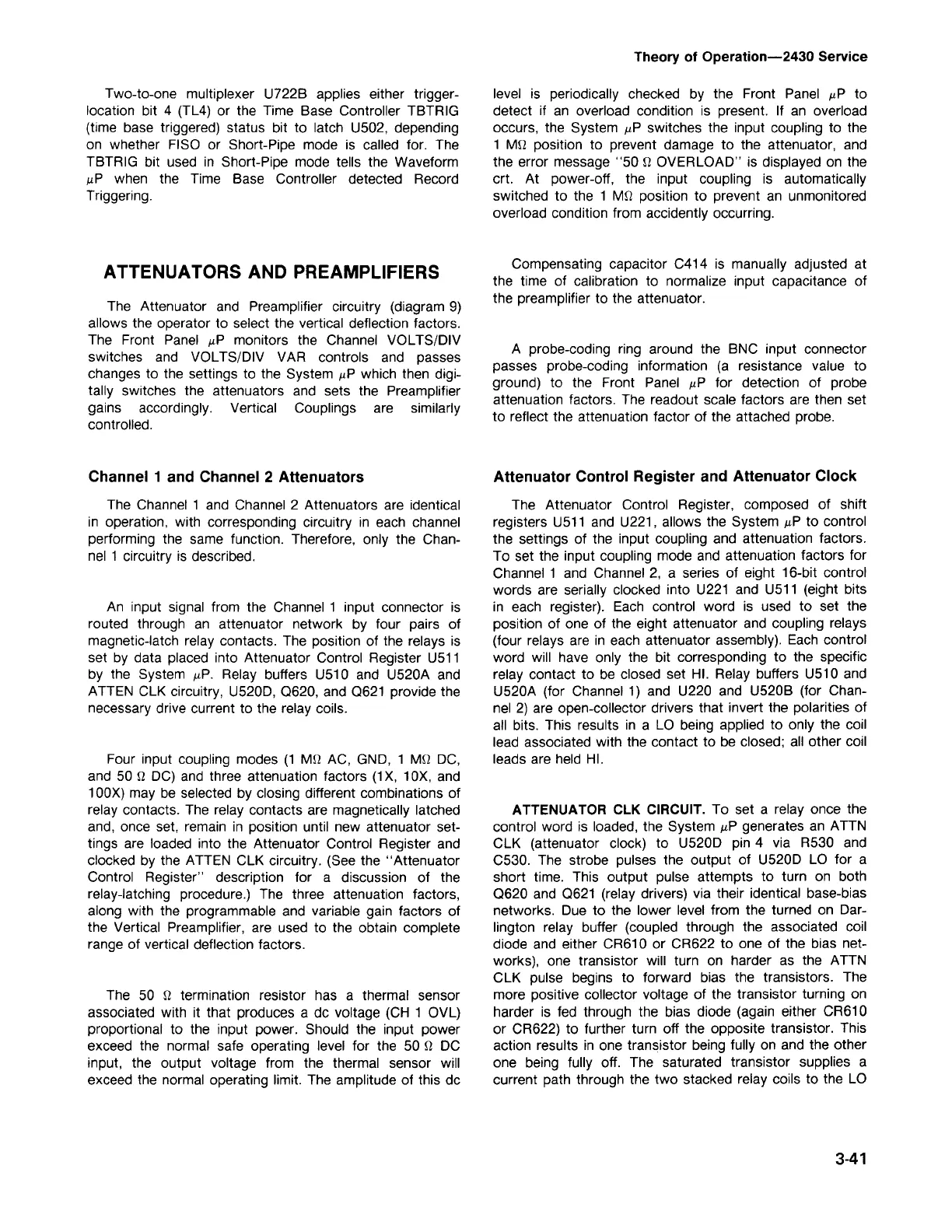3-41
ATTENUATORClK CIRCUIT.To set a relay once the
control word is loaded,the System /-lPgeneratesan ATTN
ClK (attenuator clock) to U520D pin 4 via R530 and
C530. The strobe pulses the output of U520D lO for a
short time. This output pulse attempts to turn on both
0620
and
0621
(relay drivers) via their identical base-bias
networks. Due to the lower level from the turned on Dar-
lington relay buffer (coupled through the associated coil
diode and either CR610 or CR622 to one of the bias net-
works), one transistor will turn on harder as the ATTN
ClK pulse begins to forward bias the transistors. The
more positive collector voltage of the transistor turning on
harder is fed through the bias diode (again either CR610
or CR622) to further turn off the opposite transistor. This
action results in one transistor beingfully on and the other
one being fully off. The saturated transistor supplies a
current path through the two stacked relay coils to the lO
Attenuator Control Register and Attenuator Clock
The Attenuator Control Register, composed of shift
registers U511 and U221,allows the System /-lPto control
the settings of theinput coupling and attenuation factors.
To set the input coupling mode and attenuation factors for
Channel1 and Channel2, a series of eight 16-bit control
words are serially clocked into U221 and U511 (eight bits
in each register). Each control word is used to set the
position of one of the eight attenuator and coupling relays
(four relays are in each attenuator assembly).Eachcontrol
word will have only the bit corresponding to the specific
relay contact to be closed set HI. Relay buffers U510 and
U520A (for Channel1) and U220 and U520B (for Chan-
nel 2) are open-collectordrivers that invert the polarities of
all bits. This results in a lO being applied to only the coil
lead associatedwith the contact to be closed; all other coil
leads are held HI.
A probe-coding ring around the BNC input connector
passes probe-coding information (a resistance value to
ground) to the Front Panel /-lP for detection of probe
attenuation factors. The readout scale factors are then set
to reflectthe attenuation factor of the attached probe.
Compensating capacitor C414 is manually adjusted at
the time of calibration to normalize input capacitance of
the preamplifierto the attenuator.
level is periodically checked by the Front Panel /-lP to
detect if an overload condition is present. If an overload
occurs, the System /-lPswitches the input coupling to the
1 MQ position to prevent damage to the attenuator, and
the error message"50
Q
OVERLOAD" is displayedon the
crt. At power-off, the input coupling is automatically
switched to the 1 MQ position to prevent an unmonitored
overloadconditionfrom accidentlyoccurring.
Theory of Operation-2430 Service
The 50
Q
termination resistor has a thermal sensor
associated with it that produces a dc voltage (CH 1 OVl)
proportional to the input power. Should the input power
exceed the normal safe operating level for the 50
Q
DC
input, the output voltage from the thermal sensor will
exceedthe normaloperating limit. The amplitudeof this dc
Four input coupling modes (1 MQAC, GND, 1 MQDC,
and 50
Q
DC) and three attenuation factors (1X, 10X, and
100X)may be selectedby closing differentcombinationsof
relay contacts. The relay contacts are magneticallylatched
and, once set, remain in position until new attenuator set-
tings are loaded into the Attenuator Control Register and
clocked by the ATTEN ClK circuitry. (Seethe "Attenuator
Control Register" description for a discussion of the
relay-latching procedure.) The three attenuation factors,
along with the programmableand variable gain factors of
the Vertical Preamplifier,are used to the obtain complete
rangeof vertical deflectionfactors.
An input signal from the Channel1 input connector is
routed through an attenuator network by four pairs of
magnetic-latchrelay contacts. The position of the relaysis
set by data placed into Attenuator Control Register U511
by the System/-lP. Relay buffers U510 and U520A and
ATTEN ClK circuitry, U520D,
0620,
and
0621
providethe
necessarydrive current to the relaycoils.
The Channel1 and Channel2 Attenuators are identical
in operation, with correspondingcircuitry in each channel
performing the same function. Therefore, only the Chan-
nel 1 circuitry is described.
Channel 1 and Channel 2 Attenuators
The Attenuator and Preamplifier circuitry (diagram9)
allows the operator to select the vertical deflectionfactors.
The Front Panel /-lP monitors the Channel Val TS/DIV
switches and Val TS/DIV VAR controls and passes
changesto the settings to the System /-lPwhich then digi-
tally switches the attenuators and sets the Preamplifier
gains accordingly. Vertical Couplings are similarly
controlled.
ATTENUATORS AND PREAMPLIFIERS
Two-to-one multiplexer U722B applies either trigger-
location bit 4 (Tl4) or the Time Base Controller TBTRIG
(time base triggered) status bit to latch U502, depending
on whether FISO or Short-Pipe mode is called for. The
TBTRIG bit used in Short-Pipe mode tells the Waveform
/-lP when the Time Base Controller detected Record
Triggering.
